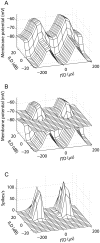Multiplicative auditory spatial receptive fields created by a hierarchy of population codes
- PMID: 19956693
- PMCID: PMC2776990
- DOI: 10.1371/journal.pone.0008015
Multiplicative auditory spatial receptive fields created by a hierarchy of population codes
Abstract
A multiplicative combination of tuning to interaural time difference (ITD) and interaural level difference (ILD) contributes to the generation of spatially selective auditory neurons in the owl's midbrain. Previous analyses of multiplicative responses in the owl have not taken into consideration the frequency-dependence of ITD and ILD cues that occur under natural listening conditions. Here, we present a model for the responses of ITD- and ILD-sensitive neurons in the barn owl's inferior colliculus which satisfies constraints raised by experimental data on frequency convergence, multiplicative interaction of ITD and ILD, and response properties of afferent neurons. We propose that multiplication between ITD- and ILD-dependent signals occurs only within frequency channels and that frequency integration occurs using a linear-threshold mechanism. The model reproduces the experimentally observed nonlinear responses to ITD and ILD in the inferior colliculus, with greater accuracy than previous models. We show that linear-threshold frequency integration allows the system to represent multiple sound sources with natural sound localization cues, whereas multiplicative frequency integration does not. Nonlinear responses in the owl's inferior colliculus can thus be generated using a combination of cellular and network mechanisms, showing that multiple elements of previous theories can be combined in a single system.
Conflict of interest statement
Figures











References
-
- Knudsen EI, Blasdel GG, Konishi M. Sound localization by the barn owl (Tyto alba) measured with the search coil technique. J Comp Phys A. 1979;133:1–11.
-
- Knudsen EI, Du Lac S, Esterly SD. Computational maps in the brain. Annu Rev Neurosci. 1987;10:41–65. - PubMed
-
- Konishi M. Coding of auditory space. Annu Rev Neurosci. 2003;26:31–55. - PubMed
Publication types
MeSH terms
Grants and funding
LinkOut - more resources
Full Text Sources
Other Literature Sources

